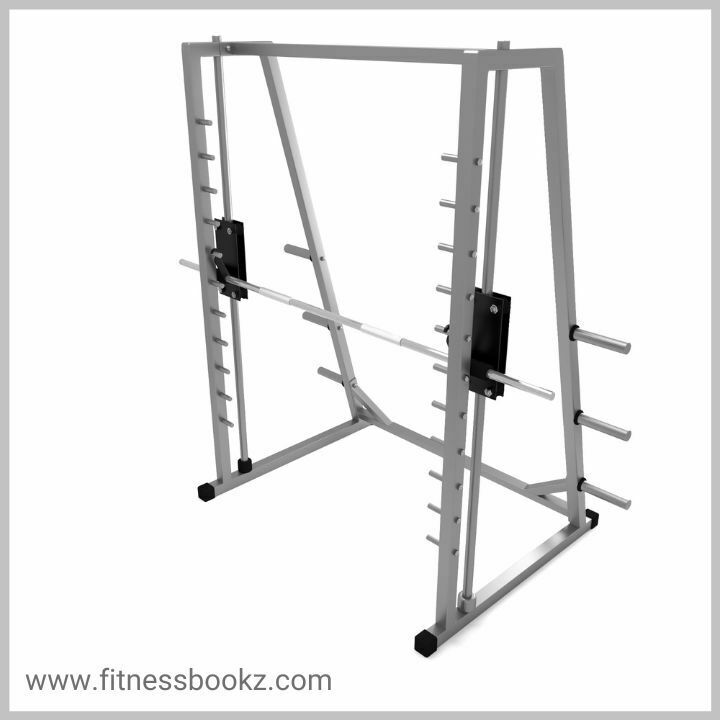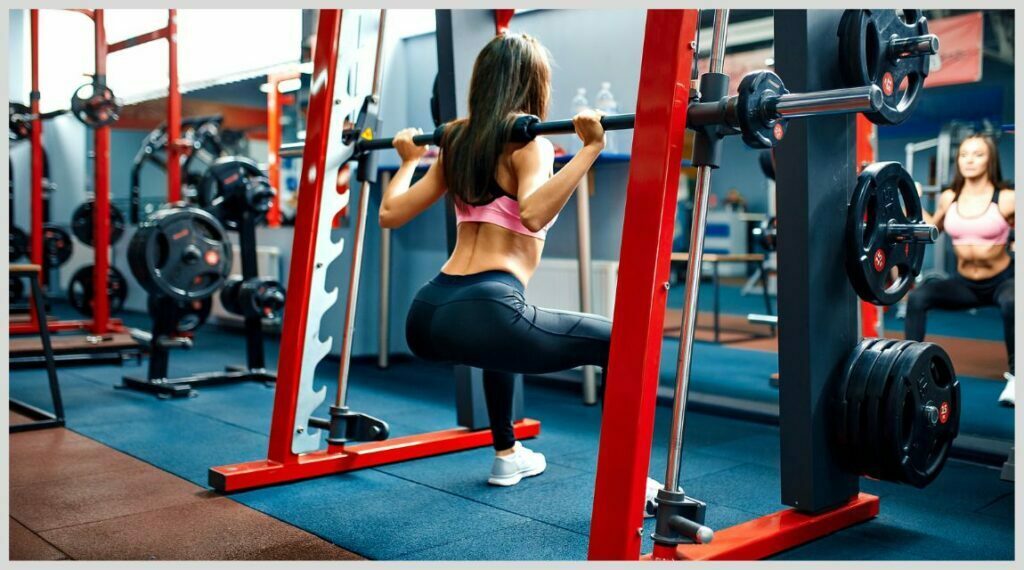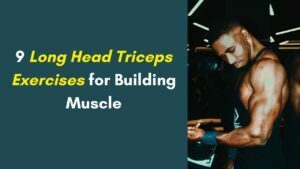Smith Machine squats are only one of an endless number of squat variants. This superior squat variant ranks high on our list of must-do workouts.
Squatting on a Smith machine is a challenging exercise for weightlifters. Smith squats are quite different from free-weight squats.
In this post, we will discuss how to do a smith squat correctly, as well as other variations and other useful information.
You should have a better sense of how to weave them into your routine by the time you finish this essay.

What is a Smith Machine Squat?
When it comes to traditional squats, the adage “there’s more than one way to skin a cat” rings especially true.
Squats have shown to be adaptable to your demands, with a wide range of options including the front squat, Prisoner squat, and Zercher squat.
There are various squat variants to choose from if the standard squat becomes boring. The Smith machine squat is an example of such a modification.
Key Highlights
1. The Smith machine squat, like other squat variants, is great for building muscular endurance and stimulating muscle growth. When compared to the standard squat, the Smith squat doesn’t deviate too much.
The usage of the Smith machine is the only distinguishing factor.
2. To work out with weights, many people use the Smith machine, which consists of a barbell enclosed by steel rails. However, numerous additional exercises may be performed in addition to squats on the Smith machine, despite its restricted vertical range of motion.
3. A Smith machine barbell, on the other hand, typically weighs between 15 and 25 pounds, however, its possible weight range is 6 to 45 pounds.
This miraculous device, which may as well be a 1950s invention yet is now a staple in every gym, is the elliptical trainer.
4. The Smith machine, created by an American called Jack LaLanne, has been a staple of commercial gyms for some decades now, despite receiving mostly negative feedback from users.
5. The Smith machine bar is great for newbies since it is simple to use, but it may also prevent you from progressing in your workouts.
If you use the Smith machine, you’ll have to stick with the same weight for every exercise until you swap it out for a heavier one.
If you’re just starting and want to polish your traditional squat, the Smith machine is where it’s at. This would ease your transition towards using bigger weights.
The Smith machine may serve as a personal trainer in your quest to achieve optimal form.
With the help of a personal trainer, you would be able to identify any flaws in your technique and greatly lessen the likelihood of injury.
The Smith Machine Squat Guide: How to Master the Perfect Form?
A Smith machine squat should feel quite natural if you can do a regular squat. If not, you should know that the Smith machine squat is simple to learn and much simpler to master.
The machine squat, like the regular squat, is most effective when performed with excellent technique. If you want to maximize your exercise, you need to do it correctly.
To begin, a squat performed on a smith machine is different from a squat performed with free weights.
You are doing a squat, although one with certain modifications because of the smith machine’s set bar route.
Arrange your feet such that they are slightly in front of your body’s center of gravity. Your knees should not move beyond your toes when you squat.
Unlike with a free-weight barbell squat, your feet will not be positioned immediately beneath the bar.
Many individuals make the common error of squatting with a smith bar by positioning their feet in a straight line beneath the bar, as they would with a free-weight barbell.
The smith machine squat is an amalgamation of the free barbell squat and the hack squat.
When you squat with a dumbbell, your feet will be around 3-6 inches farther apart than when you squat with a barbell.
It’s best to start with an empty bar so you can establish your footing.
The prevalent belief that “smith machine squats are harmful” is incorrect, or at most, the same risk as there is for any exercise if you place your feet in the right position. Injuries are possible with any physical activity if an improper form is used.
To do a smith machine squat, one must follow these steps correctly:
Preparing the Smith Machine
It’s important to check the Smith machine’s readiness before beginning squats. So, let’s start at the bar.
Adjust the Smith machine’s bar so that it is at or slightly above shoulder level. If you leave it too high or too low, you’ll be carrying an excessive amount of weight.
When you’re standing, the greatest place to rest the barbell is on your upper traps and rear delt.
Therefore, it will need to be positioned somewhat lower than that. If you do so, you won’t have to stand on your tiptoes to raise it.
The safety bar should also be at knee height. The placement of the safety catch allows you enough clearance, ensuring your safety as you work.
Afterward, you may begin piling dishes onto the bar. However, it’s important to get the ball rolling slowly.
Initial Position
Submit yourself to the underworld of the bar. Your traps and back delts should support the bar, not your neck.
Put your hands on the bar so that your shoulders are apart. Modify the workout according to whatever your needs and preferences might be.
You should stand with your feet approximately hip-width apart and your toes turned outward at a little angle. Keep in mind that you should practice foot placement on an empty bar first.
When squatting, you should aim to maintain your back straight and your knees behind your toes.
At the bottom of the squat, your knees and toes should be in a nearly straight line.
Your arms should be at your sides, but slightly behind your body. At this point, you’ll need to raise your body slightly and twist your wrists back to unhook the bar.
Keeping your wrists from rotating forward will prevent the hooks from re-hooking, so be careful to move them out of the way.
Keep your feet below the barbell and your hands close to your torso.
If you want to get the most out of this exercise, make sure your hands are shoulder-width apart when you grab the bar.
Keep your shoulders back and your chest out at all times. As soon as the bar is freed, you may take a deep breath and start your descent.
The Descent
While bending your knees and lowering yourself, you should also tilt your pelvis back somewhat.
Maintain an upright posture with your chest out, shoulder blades back, and head up. Your spinal health will be protected in this way.
You must hold on tightly to the bar with the help of an overhand grip. Watch out that it doesn’t settle on the locating pins.
Heel-to-toe walking is putting your weight on your heel instead of your toes.
To squat, you should first bend at the hips and then at the knees. Keep your back and neck perfectly motionless as you lower yourself into a sitting position.
The optimal depth is just beyond parallel, with the butt in line with the calves.
Building muscle and strength is facilitated by a steady stream of tension in the limbs, and this is especially effective for the quadriceps (and glutes).
Insert the bar so that it lies flat on your traps between your neck and upper back. When you inhale, concentrate on contracting your abdominal muscles to pull your stomach in.
To unrack a bar, bring it up and forward with your wrists as you exhale.
The Ascent
Now is the time to let out some air and launch yourself upward from your plantar femora.
Be sure to maintain your back and neck aligned, your elbows pointed, and your core tight during the whole process.
The angle at which your knees bend should be 90 degrees, and your thighs and calves should create a straight line.
Keep your chest out and your back slightly arched to exude self-assurance. Avoid putting unnecessary weight on one leg.
You should be able to reach a neutral hip position at the top, but not quite a complete knee lockout.
Keep your knees a little bent while you are in a standing position. Then, do it again.
Hold this position for at least one second. Without breaking your form, push up from your lower body into a sitting position. As you get up, be sure to squeeze your glutes.
That is to say, this is a single instance of a similar phrase. In the allowed time, do as many repetitions as feasible.
Muscles Worked by Smith Machine Squats
We can observe the same muscles being worked in the Smith machine squat as in the traditional barbell squat, which is a great advantage of this straightforward exercise.
The Smith machine is great for developing strong quadriceps, tight glutes for a perkier derriere, and toned calves.
When you squat on the Smith machine correctly, you work your abs, stabilizer muscles, and core.
All other muscle groups are engaged as support muscles to help with movement, but your gluteus maximus, gluteus medius, gluteus minimus, and hip adductors will feel the most effect from this exercise.

Quadriceps
Smith machine squats target the quadriceps, a group of four muscles that include the rectus femoris, vastus lateralis, vastus medialis, and vastus intermedius.
Complete development of the group is the goal of the Smith squat.
The quad is a large, plump muscle that runs the whole front and outside edges of both thighs.
They fasten around the leg and make it easier to do things like stand, walk, run, climb, and leap.
When doing a squat on the Smith machine, the extent to which you engage your quadriceps (or any other muscle group) relies on your posture.
The position of your feet on a smith squat places greater emphasis on your quadriceps than that of a free-weight barbell squat, which uses both legs equally.
In the long term, this will help you tone and develop your quads, which is great since having strong legs is crucial in the weight room.
Hip Abductors
Your hip abductors are worked out, too, when you squat on a Smith machine. The tensor fasciae latae, gluteus medius, and gluteus minimus are the hip abductors.
Muscles on the outside aspect of the thighs help you stand up straight by stabilizing your pelvis, and they also work together to propel you forward by rotating your legs outward.
Most of the work of the hip adductors will be done while the hips are flexed, at the bottom of the lift.
As a result, your hip adductor will be used more as you go lower. During the squat’s descent, they get into action. The more you squat, the more your adductors get going.
Glutes
Gluteus maximus muscles aid in stability, balance, and gait. In contrast, the tensor fasciae latae is attached to the pelvis and aids in gait, regulation, and the abduction of the legs generally.
The Smith machine squat is one of the few workouts that specifically target the muscles used in this movement.
Your glutes and other hip abductors (those that pull your legs out to the side) will have to work harder the wider your stance.
But even in a “regular” posture, if your range of motion is unrestricted, your glutes will be stimulated to a significant degree.
Calves
When doing a squat on a Smith machine, you still work your calves and hamstrings equally via weight and ankle flexion; after all, it is still a complex exercise.
Squats need the calves’ participation in two distinct ways:
During ankle flexion and stability. With a smith machine, you won’t need much in the way of stability, so you’ll simply be using your calves depending on the movement of your ankles.
Your calves will be worked harder if you go lower and heavier.
Abdominals And Spinae Erectors
Abdominal muscles are used less during a Smith machine squat than they are during a free-weight squat.
Because of how the machine is built, your abdominal muscles won’t have to work as hard to keep you steady.
In either case, you’re using your abs and muscles. Your lower back muscle and spinal erectors are recruited to a lesser degree, despite your erect posture.
When compared to a regular free-weight squat, a squat machine reduces the load on your lower back muscles and doesn’t put enough stress on your erectors (which are utilized for stability).
Muscles in the back, called spinal erectors, help you stand up straight. If you try to bend over, your erector spinal muscles will automatically contract to prevent that.
Abs
To stabilize your movement, your core must work hard during heavy free-weight squats, which is why they are beneficial.
This need is no longer necessary thanks to smithing machines. That means you’ll be doing significantly less effort in your core as a result.
Anyway, you should still perform some ab/core-specific workouts, even if you’re doing barbell squats.
Without a doubt, squats are not enough to build a strong core and abdominal muscle. Because of its versatility, your core has to be engaged in every single motion.
While barbell squats are excellent for building general core strength, core-specific workouts are necessary for effectively targeting the abs and other core muscles.
Hamstrings
Squats are so popular among new exercisers that they are sometimes mistakenly thought to work every muscle group below the waist.
Squats, with or without the use of a Smith machine, do not provide sufficient emphasis on the hamstrings.
Neither the bottom nor the top of your squats truly activates your hamstrings.
That’s why, whether you choose the smith machine or the squat rack, you have to include some hamstring-specific workouts into your routine.
Benefits of Using Smith Machine Squats in Your Routine
There are several possible advantages to using a Smith-Assisted Squat machine. Some of the most prevalent uses for this machine are listed below.
1. Facilitates Muscle Isolation
To target your quadriceps and glutes, put your feet in front of the Smith machine. Keep your feet together if you want to focus more on your quads.
The freedom to adjust body position and not worry about stability makes Smith machines particularly efficient for isolating the quadriceps and glutes.
You may target different muscles by switching to one of the numerous available variants.
Because of this, the Smith machine is used for squats by professional bodybuilders.
It’s a fantastic accessory/assists lift since it combines the benefits of both a compound exercise and an isolated exercise.
2. You Won’t Have to Use a Spotter
As opposed to free weights, the Smith machine is simpler to use. Because the bar travels in a straight line, you won’t have to worry about maintaining your balance or form.
The machine’s catch mechanism, which consists of hooks and pins, also serves as a kind of spotter, which is a nice additional bonus.
As much as you want throughout your workout, you may rack and unrack the bar thanks to these hooks and pins.
Because of this safety net, injuries are less likely to happen.
No matter how much you try to perfect your technique, the free-weight barbell squat will always put your stance first.
The Smith machine gives you a safer, more regulated way to practice proper posture.
3. Expert Lifters Can Try New Weights and Techniques
Smith machines greatly reduce the requirement for balancing. This implies advanced weightlifters may increase their workloads and make greater improvements.
Smith machine squats allow you to try out different grips and hand placement since you don’t have to worry as much about maintaining your balance.
You may vary your squat routine by practicing in different postures or by increasing or decreasing the level of difficulty.
This allows you to alternate which muscles you’re using and to adjust the intensity with which they’re being contracted.
4. Chances of Injuries are Reduced
The ability to maintain concentration on technique and the catch system may help lessen the likelihood of injury when lifting.
Naturally, this does not mean that there is no possibility of harm at all. Good form and technique are essential for every kind of physical activity.
For example, if you make a mistake in your technique while doing a standard barbell squat, you might inadvertently activate the incorrect muscles, increasing the risk of muscular damage.
The form may be refined while using the Smith machine. While it’s true that exercise machines may provide some risk, the Smith machine poses no such threat so long as you follow the safety instructions.
5. Beginner-friendly
Squatting on a Smith machine is a great warm-up for more advanced squat exercises.
The Smith machine squat is an excellent starting point for those who have never performed a squat before or who have never been taught the proper form.
This variation of the traditional barbell squat reduces the intensity and demands on the body significantly.
The Smith machine squat is a fantastic introduction to squatting while carrying weights.
Common Smith Machine Form Mistakes
The form is everything when it comes to Smith squats. Here are five of the most typical errors in the form that people make when squatting with this apparatus.
- The most common error is treating the smith squat as if it were a normal squat.
- For beginners, going too quickly during a squat is the most prevalent pitfall.
- Curving your spine is a bad idea in any squat position. You may easily injure yourself by doing this.
- Keep your knees from caving in when doing Smith squats. Some knee injuries may be caused by an outward or inward bending of the knee.
- The tendons and joints take the brunt of the force as you push off with the balls of your feet. On the rise, keep your toes down and put your weight on the heels of your feet to generate forward momentum.
While working out on the smith machine keep in mind that you do not make these mistakes and you can have a great workout session without hurting yourself!
Access the full benefit of this workout by keeping in mind all the points we have mentioned throughout the blog!
Final Words
The Smith machine squat is a wonderful variation of the traditional squat. It takes little time to master and yields comparable muscular gains.
However, you must pay close attention to your form during the whole practice. You may benefit greatly from including the Smith machine squat in your keg day workout.
The Smith machine squat, when used in conjunction with other compound barbell exercises, is a great way to build up strength across the board.
Given the advantages we’ve discussed, you may want to consider adding this to your home gym.
FAQs
1. Is the Smith machine good for squatting?
2. What is the name of squatting exercises performed on a Smith machine?
The front squat that you perform on the Smith machine has the advantage of compelling you to focus on your lower body rather than your upper body as the limiting factor in the exercise.
3. When using the Smith machine, do you get stronger glutes?
The Smith machine may be unfairly vilified because it is not an exercise that uses “free weights,” even though it is an effective technique to target the glutes.





Pingback: 15 Best Dumbbell Chest Exercises for Upper Body Workouts
Pingback: Top 12 Dumbbell Leg Exercises to Build Bigger Legs Fast
Pingback: How Much Does a Smith Machine Bar ACCURATE Weigh?